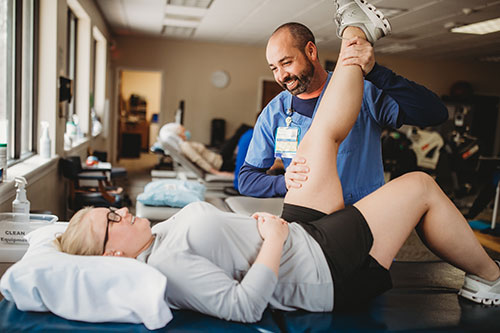Knee Symptoms
 Understanding Knee symptoms
Understanding Knee symptoms
What is covered in the understanding symptoms section?
What do symptoms mean? Can you self diagnose your knee problem? How can you decide if you need to see a doctor for your knee pain? Here is some helpful information.
Indicators of a serious problem
- The pain is very intense
- The pain comes on very strong and suddenly
- You hear a pop from your knee area

Misleading symptoms
Sounds:
If you hear grinding in your knee as you flex and extend the leg, you may think you have a knee problem, but in some cases that grinding sound may be normal, especially if there is not associated pain or discomfort. Noises, when accompanied by pain, should always be taken seriously.
You should have a knee specialist check them out to be sure you are not doing further damage to the knee joint. A loud "pop" for example that comes from an abrupt physical movement, during basketball or tennis, can signal a torn anterior cruciate ligament. There may also be a feeling of instability or nausea. A torn ACL is very serious and needs the attention of a knee specialist promptly.
* Pain:
Some serious problems are not even painful at first. Generally speaking, the immediate onset of pain is a sign that something serious is wrong and you need to see a knee expert. But also be aware that sometimes serious problems can develop that DO NOT produce excruciating pain.
*Note:The more of these symptoms you exhibit and the more intense they are, the worse the problem could be.
How a doctor diagnoses knee problems
When a patient visits a knee specialist to help diagnose a knee problem, there are three parts to the examination; the medical history, the physical examination, and diagnostic imaging.
 During the medical history, the knee surgeon will try to find out if you have developed your problem through heredity, through lifestyle habits or through a sudden sports injury. This will give the physician the best idea of how to find out exactly what is wrong, and then suggest proper treatment of the injury. You should indicate to your doctor if you have been using steroids since they can cause joint inflammation. Lyme Disease from the deer tick and rheumatoid arthritis can also trigger joint inflammation, for instance.
During the medical history, the knee surgeon will try to find out if you have developed your problem through heredity, through lifestyle habits or through a sudden sports injury. This will give the physician the best idea of how to find out exactly what is wrong, and then suggest proper treatment of the injury. You should indicate to your doctor if you have been using steroids since they can cause joint inflammation. Lyme Disease from the deer tick and rheumatoid arthritis can also trigger joint inflammation, for instance.
Following the medical history, your doctor will give a physical examination to see if he can hear or feel what is wrong. This portion of the exam is somewhat like a carpenter trying to find out why a hinge on a door is squeaking or is not properly aligned by opening and closing the door a few times to listen to what is going on. This will show the doctor which tests he or she should perform to find out the cause of your pain.
Next, the physician may have an MRI or x-ray image taken of your knee. An x-ray often times does not provide the clarity needed to see precisely what is wrong. In these instances, an MRI or CT-Scan is used. X-rays, for example, only show bones. MRI and CT-scans show soft tissues.
